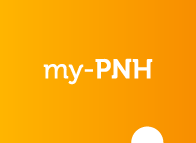Glossary
Glossary of medical terms
Here you can find definitions to the most frequently used medical terms in PNH.
A condition that occurs when there are not enough red blood cells to effectively carry oxygen around the body, which can cause fatigue, shortness of breath and headaches.
Medicines that are useful to prevent coagulation (clotting) of blood.
The inhibition of blood coagulation in the form of prophylaxis or therapy. Anticoagulation is usually achieved by administering anticoagulant drugs.
A type of blood vessel responsible for carrying blood from the heart to different parts of the body.
The yellow-brownish breakdown product of haemoglobin (red blood pigment). Elevated levels of bilirubin in the blood may indicate increased haemolysis.
Part of the blood that is considered non-cellular. This portion, consisting of water and substances dissolved in it, makes up about 55% of the blood volume.
A diagnosis tool for PNH. It checks whether the mutated blood cells have a lower amount or missing certain proteins on their surface.
Difficulty swallowing.
Shortness of breath or difficulty breathing, which is often characterised by shallow and/or rapid breathing or pronounced deep breathing.
Red blood cells in the human body.
The premature breakdown of red blood cells (haemolysis) outside the vascular system.
Pathological exhaustion despite adequate sleep and rest. Fatigue is a common side effect of many chronic diseases.
The red blood pigment found in erythrocytes (red blood cells) that enables oxygen transport in the bloodstream.
Excretion of haemoglobin (red blood pigment) in the urine.
It is the destruction of erythrocytes (red blood cells) inside or outside the body.
A special form of anaemia resulting from haemolysis.
The premature destruction of red blood cells (haemolysis) in the vascular system.
The substance that is in the cavities of bones, which is responsible for the formation of blood cells.
When the bone marrow produces insufficient amounts of blood cells. This is also known as bone marrow insufficiency.
The complement system is part of the immune system and helps to fight off infections (e.g. caused by bacteria). It is also important in maintaining homeostasis.
The proteins which compose the complement system. These are important for the regulation of the complement system.
A network of plasma proteins and cell surface receptors which recognise foreign components and trigger the activation of the complement pathways.
Inhibition of the complement system. Complement inhibitors are used in PNH therapy, and act by preventing the complement system from destroying all mutated blood cells.
An enzyme found in the body´s cells such as red blood cells, that is released upon cell destruction. In the course of PNH diagnosis, LDH testing can provide information about the degree of intravascular haemolysis in the body.
Another term for white blood cells, which are intended to, for e.g., protect the body from pathogens. Leukocytes are also involved in tissue repair.
A change in genetic information. This can be congenital (from birth) or acquired (as with PNH).
"Seizure-like".
A rare disease of the blood-forming system, in which the complement system is activated because red blood cells have decreased or missing surface structures that would otherwise protect them from complement-mediated destruction. The red blood cells burst (haemolysis) and the red blood pigment is often excreted in urine (haemoglobinuria).
The gene involved in the production of so-called glycophosphatidylinositol anchors. These in turn protect cells from attacks by the complement system by attaching protective proteins to the cell surface
Blood cells affected by certain PNH mutations, which lead to reduced presence or lack of specific proteins on these cells.
An increased tendency to thrombosis. This is caused, for example, by a change in the blood cells or the vessel walls.
The formation of a potentially serious blood clot, which may block veins or arteries. This can lead to a heart attack, stroke and/or serious organ damage.
Components in the blood that play an important role in stopping bleeding. Also called thrombocytes.
Blood vessels that transport the blood circulating in the body back to the heart.
